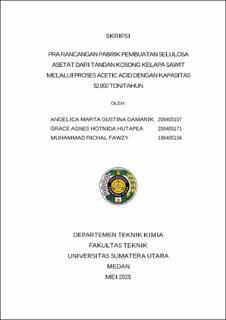Pra Rancangan Pabrik Pembuatan Selulosa Asetat dari Tandan Kosong Kelapa Sawit Melalui Proses Acetic Acid dengan Kapasitas 52.000 Ton/Tahun
Preliminary Design of Acetate Cellulose Factory from Empty Palm Oil Bunches Through Acetic Acid Process With a Capacity of 52,000 Tons/Year

Date
2025Author
Damanik, Angelica Marta Gustina
Hutapea, Grace Agnes Hotnida
Fawzy, Muhammad Richal
Advisor(s)
Manurung, Renita
Fath, Muhammad Thoriq Al
Metadata
Show full item recordAbstract
The preliminary design of a cellulose acetate production plant from Oil Palm Empty Fruit Bunches (EFB) using the acetic acid process is planned with a capacity of 52,000 tons/year and will operate for 330 days per year. The amount of EFB required is 9,767.56 kg/hour.
The production process in this preliminary plant design consists of four main stages: preparation of EFB as raw material, pulping and bleaching, acetylation followed by neutralization and hydrolysis, and finally the purification of cellulose acetate. During the production process, saturated steam is used at 4,122.414 kg/hour, cooling water requirements are 14,294.929 kg/hour, electricity consumption is 347.54 kW, and fuel consumption is 92.17 kg/hour.
The plant is planned to be located on Jalan Suak Lanjut, Siak Subdistrict, Siak Regency, Riau, with a total land area requirement of 20,834.88 m². The plant will employ 224 personnel, and the chosen business entity is a Limited Liability Company (PT) with a line and staff organizational structure.
The economic analysis results of the preliminary design of the cellulose acetate plant from EFB are as follows:
1. Capital Investment (CI) = Rp3,487,222,751,057
2. Total Cost (TC) = Rp5,898,502,599,782
3. Profit Margin (PM) = 12.74%
4. Break Even Point (BEP) = 40.17%
5. Return on Investment (ROI) = 15.26%
6. Pay Out Time (POT) = 6.55 years
7. Return on Network (RON) = 25.43%
8. Internal Rate of Return (IRR) = 17.91%
Based on the economic analysis, it can be concluded that the preliminary design of the cellulose acetate production plant from EFB with a capacity of 52,000 tons/year is feasible to establish.
Collections
- Undergraduate Theses [1239]
